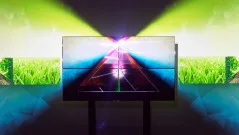The main IFA keynote was given by Sang Beom Han, President and CEO of LG Display whose talk was entitled “How Displays Will Change Your Life”. We were pleased to see displays as a main topic and for a panel maker to give us its views.
Han was introduced by Jens Heithecker, IFA Excutive Director, who said that 1645 companies are exhibiting this year at IFA, occupying 150,000 sq m² – more than 21 soccer fields (28 US football fields). Heithecker said that displays are critical to the technology future because we are visual creatures. More and more of the surfaces in our homes will be displays.
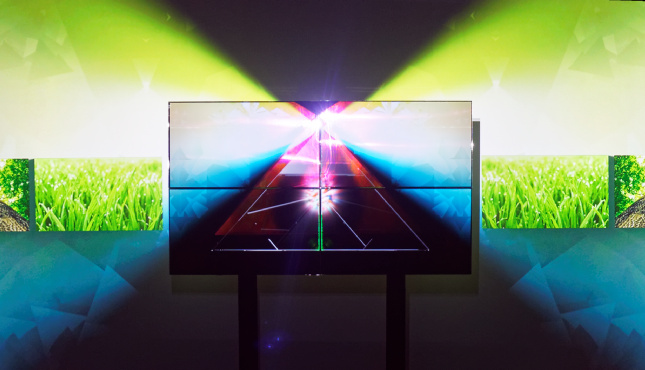 Four big displays were propelled into the middle of the stage to create a small video wall in the middle of the projection area. After some video action, they wheeled themselves off again! (we’re not convinced it was worth what must have been a considerable effort to make this work!)
Four big displays were propelled into the middle of the stage to create a small video wall in the middle of the projection area. After some video action, they wheeled themselves off again! (we’re not convinced it was worth what must have been a considerable effort to make this work!)
Han said that he would explain how the history of light will lead to the future of displays. Light has been involved in many innovations, from fire to candles. The electric light bulb changed the world forever, delivering many more hours in the day. Light was used for motion pictures and photography, which triggered learning and communication. The CRT had a profound impact on the world with TVs and computers. But people wanted thinner and better displays.
This desire lead to the development of the LCD as the core display device in the world for many applications.
“Will this revolution continue?”, Han asked. Displays are everywhere – in our pockets and bags as well as our homes and offices. Science fiction shows people calling up images simply with touches and words.
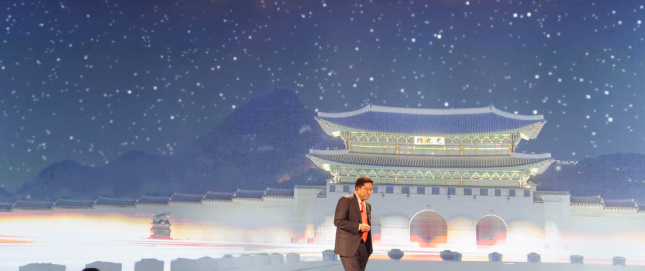
Han then showed a video of consumers saying that they want displays that are attractive on their own and with a variety of different attributes of size, flexibility and colour. (and I have to say, they all looked “scripted”! – Man Ed.)
What makes a perfect display? Really, they have to show reality – the world as it really is. Han talked about a famous Korean painter, whose paintings were said to be so good that birds tried to land on his drawings of trees. Displays need to have perfect colour, perfect black and perfect white.
Displays need dynamic form. We usually think of displays as being rectangular flat shapes, but in the future, displays will need to take on multiple shapes and forms.
The technology to show reality and have dynamic form to do this is OLED. “With OLED we see the future”, he concluded.
“But is OLED good enough to be the display of the future?”, he asked.
Dr Han introduced Ching W Tang as the “father of OLED”, although Tang was not sure he could claim that. OLEDs are organic and in nature, there is luminescence from insects, light emission from algae and also photoluminescence. Tang explained the basic mechanism of OLEDs, based on his discovery at Eastman Kodak, that some materials could emit light. He developed PN structures to make more efficient displays. Doping allowed the creation of different colours in the OLEDs.
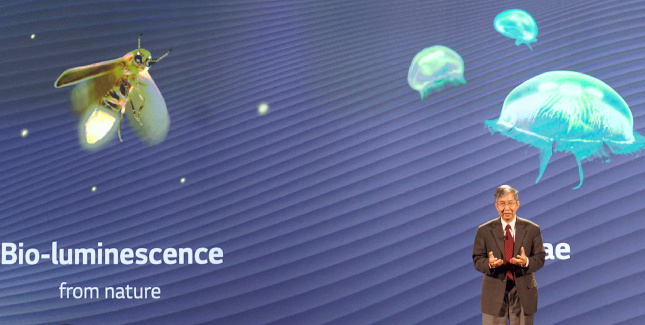 Ching W Tang “father of OLED”
Ching W Tang “father of OLED”
The structure has been developed to be more complex now to create the real products that we can buy. Of course, you have to be better than LCD, but LCD cannot make a perfect black, so it always has limits. It also has speed problems. The OLED industry has been able to develop perfect displays, said Tang and OLED can be foldable, wearable, transparent and flexible.
The next speaker was Sir Ridley Scott, the famed movie director, who said that he wants to see a movie in the best possible quality. With home viewing, the display is not usually perfect. Scott said that he recently looked at some of his movies on TVs and they looked exactly the way he wanted.
The next speaker was Dr Peter Zec, the Founder and CEO of the Red Dot design awards. Zec said that there are two aspects to design – use and aesthetics – and products are created by combining materials and technology. Zec said his definition of good design is “good function, seduction, use and responsibility”. We can fall in love with the product. Sometimes, though, beautiful products are not good to use. Of course, products have to be green, but should be made in a sustainable way. Products should also be available to all, not just for the rich.
Red Dot selects from submissions, then presents those designs in its books, websites and museums. The best TV this year was the LG flexible OLED TV, the 77EG9900 which can change from flat to curved and back. That product won the “best of the best” award from Red Dot.
Han returned to ask if the audience could see OLED as the future? Bendable and double sided OLEDs have been developed. A very flat wall-mounting TV has also been developed. The development of OLED has been very difficult and there were many setbacks in getting to ship an OLED TV. However, there is still a long way to go and many possibilities based on a wide and open imagination.
LG Display is working with its partners to develop OLED-based products based on new materials and equipment as well as customer needs.
Han showed a video of LG engineers who said that the company has developed flexible OLEDs for the future. Idemitsu Kosan, which develops OLED materials, was also shown as well as Tokyo Electron which has developed inkjet printing of OLEDs. Tetsuro-san said the equipment is the first large area manufacturing using inkjet. Julie J Brown of UDC talked about what OLED brings to the consumer. UDC has been working with LG Display for more than ten years.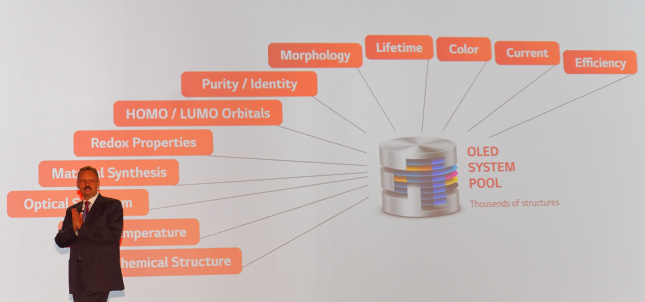
The next speaker was Dr Udo Heider, VP of the OLED unit from Merck. Merck was involved in LCD since the 1970s, and is now engaged with the new possibilities of OLED. OLED has many materials – it’s about new molecules and they have to be brought to life. The new molecules have to interact in the way that is desired. That means a great integration of chemistry, physics, optics, engineering and science. The challenges are to get to industrial products and make big displays, you need to do much more in collaboration and integration. You basically pack a CRT into a micro metre, Heider said.
Merck shares the vision of LG and the company is investing more and more each year in the technology. Merck is committed to making OLED real and bringing it increasingly to products.
Finally Han said that LG has taken “the road less travelled”.
Analyst Comment
I have been very critical in the past of LG Display’s marketing, especially the launch of its passive 3D technology. However, there was clearly a huge effort that went into this keynote which, although it didn’t really teach us anything new, was very well put together and presented.
It clearly commits LG to a huge push with OLED, at least while Han remains in charge. After this speech, we suspect it would be hard for him to stay if LG’s OLED plans fail.
At the press event, LG showed a double-sided OLED, which was very thin and also the flexible wall-mounted OLED that it recently showed in Korea (see picture below) The company also showed a 111″ “wave” OLED, but outside retail or public display, we couldn’t imagine many uses. (BR)


